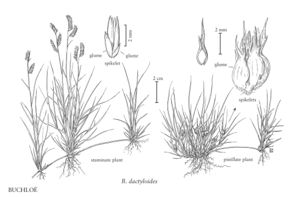Difference between revisions of "Buchloë dactyloides"
FNA>Volume Importer |
imported>Volume Importer |
||
| (8 intermediate revisions by 2 users not shown) | |||
| Line 16: | Line 16: | ||
-->{{Treatment/Body | -->{{Treatment/Body | ||
| − | |discussion=<p>Buchloë dactyloides is a frequent dominant on upland portions of the semi-arid, shortgrass component of the Great Plains, ranging from the southern prairie provinces of Canada through the desert southwest of the United States to much of northern Mexico. Collections from east of the Mississippi River and south of the Ohio River probably represent recent introductions.</p><!-- | + | |discussion=<p><i>Buchloë dactyloides</i> is a frequent dominant on upland portions of the semi-arid, shortgrass component of the Great Plains, ranging from the southern prairie provinces of Canada through the desert southwest of the United States to much of northern Mexico. Collections from east of the Mississippi River and south of the Ohio River probably represent recent introductions.</p><!-- |
| − | --><p>Buchloë dactyoides provides valuable forage for livestock and wildlife, and withstands heavy grazing. It may be confused in the southern portion of its range with Hilaria belangeri, which consistently has pilose nodes, or in the Big Bend region of Texas with Cathestecum erectum, which has three spikelets per node and distinctly awned lemmas.</p> | + | --><p><i>Buchloë</i> dactyoides provides valuable forage for livestock and wildlife, and withstands heavy grazing. It may be confused in the southern portion of its range with <i>Hilaria belangeri</i>, which consistently has pilose nodes, or in the Big Bend region of Texas with <i>Cathestecum erectum</i>, which has three spikelets per node and distinctly awned lemmas.</p> |
|tables= | |tables= | ||
|references= | |references= | ||
| Line 26: | Line 26: | ||
-->{{#Taxon: | -->{{#Taxon: | ||
name=Buchloë dactyloides | name=Buchloë dactyloides | ||
| − | |||
|authority=(Nutt.) Engelm. | |authority=(Nutt.) Engelm. | ||
|rank=species | |rank=species | ||
| Line 33: | Line 32: | ||
|basionyms= | |basionyms= | ||
|family=Poaceae | |family=Poaceae | ||
| + | |illustrator=Linda A. Vorobik;Karen Klitz | ||
| + | |illustration copyright=Utah State University | ||
|reference=None | |reference=None | ||
|publication title= | |publication title= | ||
|publication year= | |publication year= | ||
|special status= | |special status= | ||
| − | |source xml=https:// | + | |source xml=https://bitbucket.org/aafc-mbb/fna-data-curation/src/200273ad09963decb8fc72550212de541d86569d/coarse_grained_fna_xml/V25/V25_904.xml |
|subfamily=Poaceae subfam. Chloridoideae | |subfamily=Poaceae subfam. Chloridoideae | ||
|tribe=Poaceae tribe Cynodonteae | |tribe=Poaceae tribe Cynodonteae | ||
Latest revision as of 17:59, 11 May 2021
Ligules 0.5-1 mm; blades 2-15 cm long, 1-2.5 mm wide. Staminate spikelets 4-6 mm long, 1.3-1.8 mm wide; anthers 2.5-3 mm. Pistillate spikelets to 7 mm long, about 2.5 mm wide. Caryopses 2-2.5 mm. 2n = 20, 40,56,60.
Discussion
Buchloë dactyloides is a frequent dominant on upland portions of the semi-arid, shortgrass component of the Great Plains, ranging from the southern prairie provinces of Canada through the desert southwest of the United States to much of northern Mexico. Collections from east of the Mississippi River and south of the Ohio River probably represent recent introductions.
Buchloë dactyoides provides valuable forage for livestock and wildlife, and withstands heavy grazing. It may be confused in the southern portion of its range with Hilaria belangeri, which consistently has pilose nodes, or in the Big Bend region of Texas with Cathestecum erectum, which has three spikelets per node and distinctly awned lemmas.
Selected References
None.
